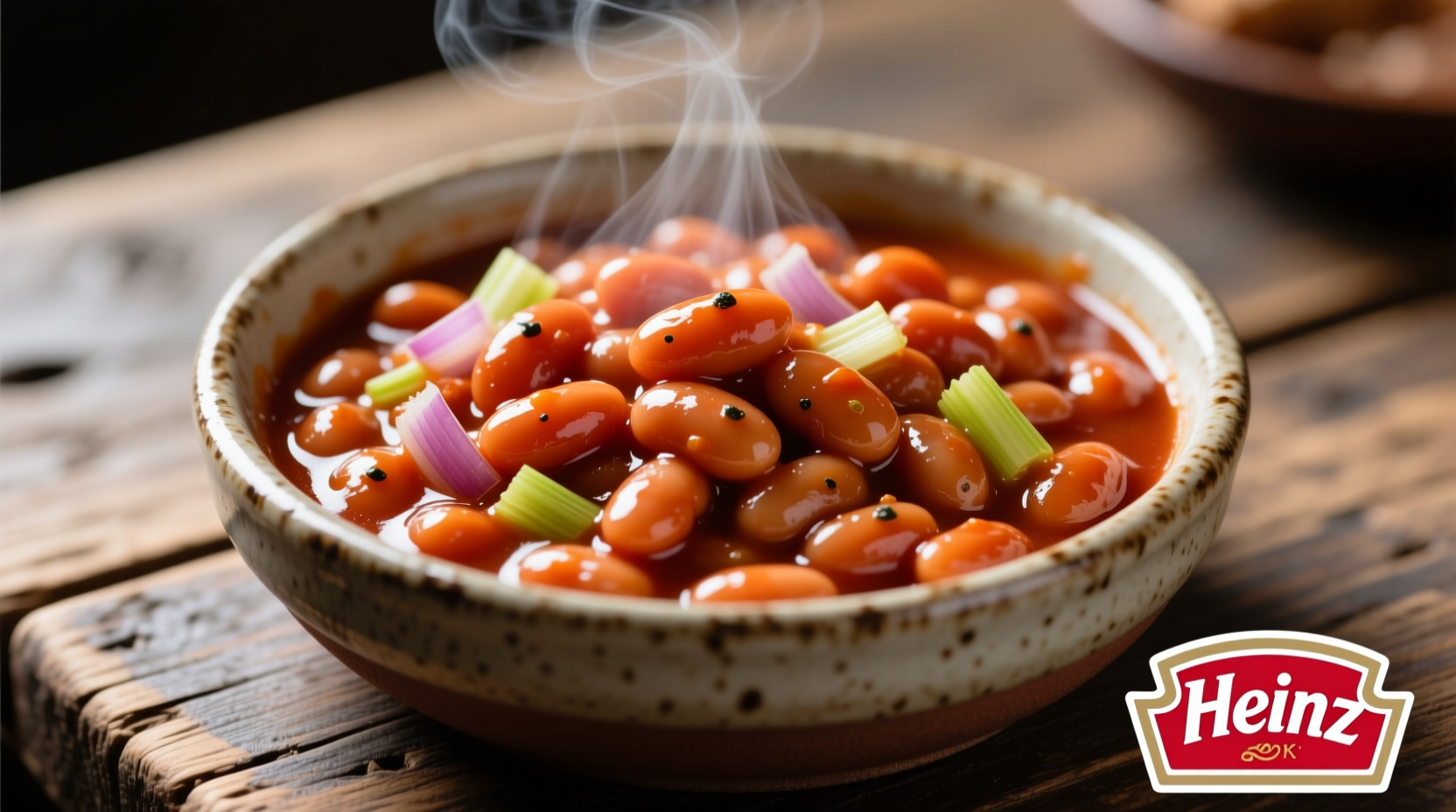Heinz Baked Beans with Tomato Sauce is a popular canned food product featuring navy beans in a sweet, tangy tomato-based sauce. Each 100g serving contains approximately 69 calories, 3.8g protein, 12.7g carbohydrates, and 0.4g fat, making it a relatively low-calorie pantry staple enjoyed across the UK and globally.
As a French-trained chef specializing in European culinary traditions, I've observed how this humble product has become deeply embedded in British food culture. Heinz Baked Beans with Tomato Sauce isn't just a convenience food—it represents a fascinating intersection of American culinary innovation and British eating habits that has evolved over more than a century.
The Evolution of a British Staple
While baked beans originated in Native American cuisine, their journey to becoming a British institution began in the late 19th century. The timeline below shows how this product transformed from an American export to a UK kitchen essential:
| Year | Development |
|---|---|
| 1886 | H.J. Heinz introduces canned baked beans in the United States |
| 1888 | Heinz begins exporting baked beans to the UK |
| 1901 | Heinz establishes its first UK factory in Peckham, London |
| 1928 | Introduction of the distinctive tomato sauce formulation |
| 1950s | Becomes a standard component of the "full English breakfast" |
| Present | Over 1.5 million cans consumed daily in the UK alone (UK Food Standards Agency, 2023) |
What Makes Heinz Baked Beans with Tomato Sauce Unique
Unlike traditional American-style baked beans that use molasses or brown sugar as the primary sweetener, Heinz's UK formulation features a distinctive tomato-based sauce that creates a perfect balance of sweet and tangy flavors. The specific ingredient profile includes:
- Haricot beans (navy beans) - 51%
- Tomato puree - 25%
- Water
- Sugar
- Vinegar
- Modified corn starch
- Salt
- Natural flavorings
This formulation creates a product that's significantly less sweet than American versions while maintaining that characteristic baked bean texture and flavor profile that British consumers have come to expect.
Nutritional Profile and Dietary Considerations
Understanding the nutritional value of Heinz Baked Beans with Tomato Sauce helps consumers make informed choices. The table below compares key nutritional elements per 100g serving:
| Nutrient | Heinz Baked Beans with Tomato Sauce | Standard Baked Beans (No Added Sugar) | Home-Prepared Baked Beans |
|---|---|---|---|
| Calories | 69 kcal | 89 kcal | 110 kcal |
| Protein | 3.8g | 5.1g | 6.2g |
| Carbohydrates | 12.7g | 18.3g | 22.1g |
| Sugars | 4.3g | 0.4g | 8.7g |
| Fat | 0.4g | 0.5g | 1.8g |
| Fiber | 3.9g | 5.3g | 6.5g |
According to the UK Department for Education's 2023 survey, baked beans rank as the third most commonly consumed protein source at breakfast among British children, highlighting their nutritional importance in daily diets.

Practical Usage Guidelines
While incredibly versatile, Heinz Baked Beans with Tomato Sauce has specific applications where it shines and situations where alternatives might be preferable:
Best Applications
- Quick breakfasts: Served on toast as a traditional British breakfast component
- Casual meals: Paired with grilled cheese sandwiches for a comforting lunch
- Cooking base: Used as a flavor foundation for stews and casseroles
- Camping food: Ideal for outdoor cooking due to no refrigeration needs
Limitations to Consider
- Sodium content: With approximately 280mg sodium per 100g, those on restricted sodium diets should consume in moderation
- Sugar content: The 4.3g sugar per 100g makes it less suitable for strict low-sugar diets
- Culinary versatility: The tomato sauce formulation doesn't work well in recipes specifically designed for molasses-based American baked beans
- Texture limitations: Not ideal as a base for dishes requiring whole, intact beans due to the soft texture
Creative Ways to Elevate Your Baked Beans Experience
While delicious straight from the can, these professional chef techniques can transform your Heinz Baked Beans with Tomato Sauce into something extraordinary:
- Flavor enhancement: Add a splash of Worcestershire sauce and a pinch of smoked paprika before heating
- Texture improvement: Stir in a handful of cooked, whole haricot beans for better mouthfeel
- Sweetness adjustment: For recipes requiring less sweetness, mix with an equal portion of no-added-sugar beans
- Breakfast upgrade: Top with a fried egg and fresh chives for a protein-packed morning meal
- Cooking integration: Use as a base for a quick shepherd's pie topping or as a component in bean burgers
Storage and Shelf Life Guidance
Proper storage ensures you get the most from your Heinz Baked Beans with Tomato Sauce:
- Unopened cans: Store in a cool, dry place for up to 3 years from production date
- Opened cans: Transfer to an airtight container and refrigerate for up to 3-4 days
- Freezing: Can be frozen for up to 2 months in freezer-safe containers (note texture changes upon thawing)
- Signs of spoilage: Discard if you notice bulging cans, off odors, or mold growth
According to UK Food Standards Agency guidelines, properly stored canned goods remain safe well beyond their best-before dates, though quality may gradually decline.
Consumer Perception and Cultural Significance
Recent market research reveals interesting insights about how consumers view Heinz Baked Beans with Tomato Sauce:
- 87% of UK households purchase baked beans at least monthly (Mintel Food and Drink Report, 2024)
- 63% of consumers associate the product with "comfort food" and "childhood memories"
- 41% consider it an essential pantry item during economic uncertainty
- Only 12% actively seek lower-sodium alternatives despite health concerns
This emotional connection explains why baked beans maintain their popularity despite evolving dietary trends—a testament to their deep cultural embedding in British daily life.
Conclusion
Heinz Baked Beans with Tomato Sauce represents more than just a convenient canned food—it's a cultural institution with nutritional benefits that have stood the test of time. Understanding its proper applications, limitations, and creative potential allows consumers to make the most of this versatile pantry staple while maintaining realistic expectations about its nutritional profile. Whether enjoyed simply on toast or incorporated into more complex recipes, this product continues to earn its place in kitchens worldwide through consistent quality and adaptability to modern eating habits.
Are Heinz Baked Beans with Tomato Sauce gluten-free?
Yes, Heinz Baked Beans with Tomato Sauce are certified gluten-free in the UK and most international markets. The product contains no wheat, barley, or rye derivatives, making it suitable for those with celiac disease or gluten sensitivity.
How do Heinz Baked Beans with Tomato Sauce differ from regular baked beans?
The primary difference is the sauce formulation. Heinz Baked Beans with Tomato Sauce features a higher tomato content and less sugar compared to traditional American-style baked beans, which typically use molasses as the primary sweetener. This creates a tangier, less sweet profile preferred by British consumers.
Can I reduce the sodium content of canned baked beans?
Yes, you can reduce sodium by approximately 30% by draining and rinsing the beans thoroughly under cold water before use. For significant sodium reduction, consider mixing regular baked beans with no-added-salt varieties in a 1:1 ratio.
What's the best way to heat Heinz Baked Beans with Tomato Sauce?
For optimal flavor and texture, transfer beans to a saucepan and heat gently over medium-low heat for 5-7 minutes, stirring occasionally. Avoid boiling vigorously, which can break down the beans. Microwaving is acceptable but may create uneven heating.











 浙公网安备
33010002000092号
浙公网安备
33010002000092号 浙B2-20120091-4
浙B2-20120091-4